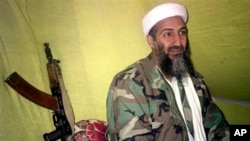The world's most wanted terrorist, Osama bin Laden, is dead at the age of 54. U.S. President Barack Obama announced that the world's most wanted terrorist was killed by U.S. forces on Sunday at a compound deep inside Pakistan.
Blamed for terrorist atrocities on at least three continents, Osama bin Laden was the target of perhaps the largest U.S. manhunt in history.
Following the catastrophic attacks on New York and Washington on September 11, 2001, President Bush publicly vowed to find the man believed to be the master mind - Osama bin Laden. "This man wants to destroy any semblance of civilization for his own power and his own good. He's so evil that he's willing to send young men to commit suicide while he hides in caves. Not only is he guilty of incredible murder, [but] he has no conscience and no soul," he said.
But bin Laden's image as the world's most-wanted terrorist stands in sharp contrast to his peaceful and comfortable upbringing.
Born March 10, 1957, he was one of more than 50 children of a wealthy Saudi construction magnate who died when Osama bin Laden was a teenager.
Raised in the opulence of Saudi Arabia's upper-class, rubbing shoulders with members of the ruling royal family, bin Laden went on to pursue an engineering degree and seemed headed for work in the family business.
But his life forever changed when, in 1979, the former Soviet Union invaded Afghanistan.
Bin Laden, like many Muslims, left home to join the fight against the Soviets, although at first his participation amounted only to logistical support for new recruits to the Afghan mujahedin Islamic fighters - the same ones supported by the United States.
But in the mid-1980's, bin Laden decided to use his share of his family's wealth to form his own militia force, which later became known as "al-Qaida" - Arabic for "The Base."
After the Soviets withdrew, bin Laden returned home, but kept ties with fellow veterans from the Afghan war and maintained an interest in other Muslim causes.
Turning point
Another major turning point in his life came in 1990 when Iraq invaded the oil-rich Persian Gulf state of Kuwait, prompting Saudi Arabia to invite U.S. troops to deploy within its territory.
Bin Laden saw the arrival of non-Muslims on what he considered holy land as an affront to Islam. He protested strongly against the move, resulting in his expulsion from Saudi Arabia in 1991.
Bin Laden found refuge in Sudan, where he is said to have orchestrated attacks on the U.S. military in Somalia and Saudi Arabia. Under U.S. pressure, the Sudanese expelled him in 1996, and he returned once more to Afghanistan.
Vikram Parekh, an analyst for the Brussels-based International Crisis Group, says bin Laden quickly became a close ally of Afghanistan's new rulers, the hard-line Islamist Taliban movement, providing them with needed funds. "It gave the Taliban an independent financial base from pure reliance for example on Pakistan for the maintenance of its administration, for the coordination of its military campaign," he said.
Terror plots
But even as he involved himself once again in Afghan politics, bin Laden stayed involved in his global struggle against the United States. He allegedly masterminded the 1998 bombing of American embassies in Kenya and Tanzania.
Parekh notes that as Osama bin Laden became associated with attacks on the West, his popularity grew among disaffected Arabs and those unhappy with U.S. policy in the Middle East. "He has become sort of an icon of resistance to the United States, regardless of whether or not people actually support Osama as an individual or the ideology he represents," he said.
Stopping bin Laden became the top priority for the United States following the New York and Washington attacks in 2001, which claimed more than 3,000 lives.
When the Taliban refused to surrender the al-Qaida leader to U.S. authorities, the United States went to war, ousting the Taliban from Afghanistan in December 2001 and sending Osama bin Laden into hiding.
Life at large
In his years at large, bin Laden released a series of audiotapes condemning the United States, causing great frustration for Washington - a frustration that has now ended.
Even before the hunt for bin Laden ended, U.S. Ambassador J. Coffer Black, former head of counter-terrorism for the Central Intelligence Agency, said it would have great meaning for many in the United States. "A good day, a day that the relatives of all the victims of 9-11 will certainly remember," he said.
But, he added, it would not mean the end of foreign terrorist threats against the United States.














